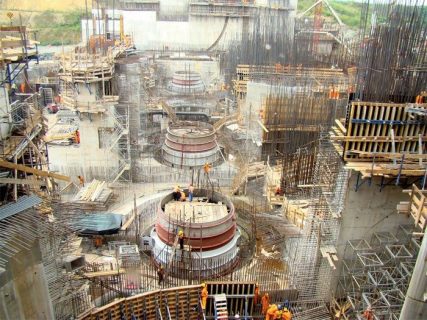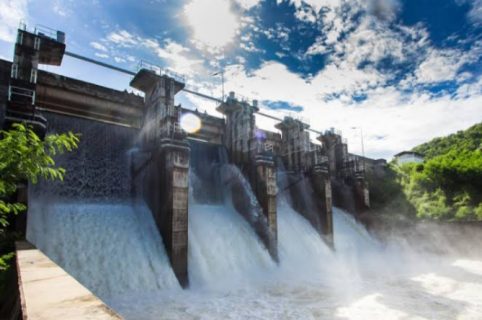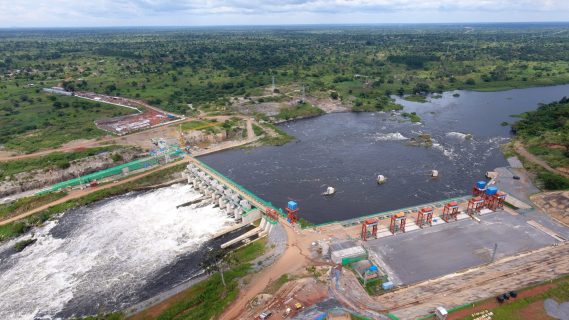Karuma hydroelectric power station project recently marked the completion of the first phase of its power units.
According to the Sinohydro plant commercial manager, Mr. Kou Zhibin there have been enormous setbacks over time. These include the Covid-19 pandemic during which the contractor was forced to limit staff thus slagging on the construction progress. However, Zhibin said they have recorded substantial progress with 99% and 99.6% of the power station and transmission lines respectively complete.
The assistant project manager for UEGCL, Mr. Paul Tumwiine, on the other said that the project is currently undergoing dry tests, which signifies the completion of the installation works.
Also Read: Latest Developments on Nyamwamba II Hydropower Project in Kasese, Uganda
“These tests,” Tumwiine explained, “only require meeting standards of safety as they are internally recognized tests for power plants. They entail ensuring equipment is installed, which is 99 percent physical progress and 1 percent activity in achieving functionality.”
Ms. Wonekha commended Sinohydro Cooperation for the successful completion of the power project which is expected to start supplying half of its generation (300MW) next year. She said, “Many Ugandans have had great expectation for the presidential promise of more power. We yearn to see more of this as the facts and figures have shown,” she said.
The Chinese ambassador, Mr. Zhang Lizhong, and his Ugandan counterpart, Mr. Oliver Wonekha, commissioned the project, symbolizing Uganda-China cooperation.
Karuma Hydroelectric Power Station Project Overview
Karuma hydroelectric power station project is being developed on the Nile River, in Kyandongo District, Uganda. Uganda’s Ministry of Energy and Mineral Development (MEMD) and Uganda Electricity Generation Company Limited (UEGCL) are spearheading the 600MW run-of-the-river power facility project.
The project comprises the construction of a 20m-high and 312m-long roller compacted concrete (RCC) gravity dam that upon completion will be the largest of its kind in East Africa. It will have a 35km-long reservoir spread across an area of 2,737ha. The estimated gross reservoir volume is 79.87 million m³.
The Karuma hydroelectric power station project will also involve the construction of six 20m-high and 29m-wide water intake towers, six 7.7m diameter and up to 379m-long concrete lined pressure shafts. In addition, a 200m-long, 21.3m-wide, and 53m-high underground powerhouse cavern housing six 100MW vertical Francis turbines will be constructed. The turbines will operate under a gross head of 70m and a speed of 150 rotations per minute (rpm).
Also Read: Latest Developments on Nyamwamba II Hydropower Project in Kasese, Uganda
Moreover, two 314m-long, 21.5m-wide, and 50m-high restricted orifice type tailrace surge chambers will also be built as part of the project. This is where water will be sent back to the river through two 12.9m diameter horseshoe-shaped tailrace tunnels approximately 8.6km long. The design discharge for the hydropower plant will be 1,128m³/s.
Power generated from the Karuma hydroelectric power station will be evacuated from an underground transformer cavern located just above the underground powerhouse. The 200m-long, 18.0m-wide, and 14.4m-high transformer cavern will be equipped with six 11kV/400kV step-up transformers and connected with the powerhouse through a 40m-long bus duct tunnel.
Three transmission lines will be used to feed the electricity generated by the facility to the national grid. These lines include the 248km-long 400kV Karuma-Kawanda line, the 55km-long Karuma-Olwiyo line, and the 80km-long Karuma-Lira transmission line. Furthermore, the project involves the construction of three new substations at Karuma, Kawanda, and Olwiyo. These will be built by the Uganda Electricity Transmission Company (UETCL).
Karuma hydroelectric power station project will cost at least US$ 1.7bn. It is financed 85% through a soft loan from the Export-Import (Exim) Bank of China, while the Ugandan government provides the remaining 15%. The loan is set to be repaid over a period of 25 years, at an average interest rate of 3%.
Reported earlier
1995
The Ugandan government first announced plans for the construction of a power station at Karuma Falls in 1995. Norpak, a Norwegian energy company was contracted to conduct the feasibility study and the environmental impact assessment (EIA) for the dam. The project was to be financed by the World Bank through a loan.
2006
In October 2006, the project’s feasibility study was released. In November of the same year, the government invited bids for the construction of the project. The initial plan was to build a 200-250 MW power station.
2009
The project plans were revised in 2009 to develop a much bigger dam of 750 MW. In the same year, Norpak withdrew from the project citing financial challenges due to the Global Recession of 2008-2012. Energy Infratech Private Limited was contracted to conduct a fresh feasibility study as well as EIA.
2011
In July 2011, the project’s capacity was scaled down to 600 MW. Some international development partners wanted to scale back even further, to a maximum capacity of 400 to 450 megawatts.
2013
Construction work at the power station officially started on 12 August 2013.
2015
In March 2015, Alstom was sub-contracted by Sinohydro, the lead contractor on the project to supply equipment and technical services to the power station. Alstom was paid $65 million in the deal.
2016
As of March 2016, around 30% of the project had been completed. The project employed around 5,000 Ugandans and 1,000 Chinese.
April 2016
Construction of Karuma dam in Uganda hit by cement and labor shortage

Contractors for the Karuma dam in Uganda have complained of a shortage of the right quality of cement and workers that has adversely slowed their operations.
In a media brief to journalists over the weekend at the construction site, the Karuma Hydropower plant project liaison officer Mr. Qu Jinwei said they were forced to source the High grade 42.5 cement from Kenya since both Hima and Tororo cement factories could not deliver the qualities they need as they are used to producing the ordinary cement.
“We inspected their factories before we started the project and we noticed that they could not supply the qualities we wanted so we had to look elsewhere and we found Savanah Cement in Kenya,” he said.
In response to the causes of the cracks in the dam, he said the cracks cannot be directly attributed to the cement used because they are negligible and they happen all the time in such types of projects. He said they would hold consultations with the parent company in China so as to rectify them. Mr. Jinwei said another major challenge encountered is the lack of qualified dumper truck drivers who can work in the tunnels where a lot of the operations take place.
“We have recruited many drivers who come on-site but when we take them to the highly restricted area where most of our operations are, many of them cannot maneuver the trucks through the tunnels,” he said.
Mr. Alok Kala, Tororo Cement’s chief marketing manager rubbished remarks over the quality o their cement saying the contractor has never bought their cement but they have been supplying to Isimba hydro dam.
One of the drivers who spoke on condition of anonymity, rubbished claims that Ugandan drivers cannot operate and manage the trucks, saying that the pay is way below the workload.
This comes barely a few days after senior officials from the ministry of energy were suspended by President Museveni after it came to light that they did shoddy work at the Karuma and Isimba dams. Among those axed are Engineers Paul Mubiru, Henry Bidasala, and Cecilia Menya
2018
As of February 2018, 74% of the project had been done. In June of the same year, 76% of the work had been completed.
April 2019
As of April 2019, around 80% of the project was complete. Three high voltage transmission lines were 80 to 85% complete at the time.
May 2019
Uganda’s Karuma power project is soon to be commissioned

Sinohydro Corporation Ltd, the Chinese firm undertaking the construction of the 600MV Karuma power dam in Kiryandongo District, has revealed that the project is 95% complete. The project which commenced in 2013 is due for commissioning in December 2019.
Also Read:Malawi signs US $150m deal for Mpatamanga Hydroelectric project
Karuma hydroelectric power plant
The project, located in northwestern Uganda, has passed through great challenges before arriving at this completion stage. The construction company had to slow down the work after having noticed in 2016 the appearance of cracks on the dam, which the company explained was caused by climatic conditions of the area.
However, the issue was resolved and construction work progressed as planned. Upon completion, the Karuma hydroelectric power plant will be the largest in the African country, with a production capacity of 600 MW.
September 2019
In September 2019, the project was 95% complete including 100% completion of the Karuma–Kawanda High Voltage Power Line, 100% of the Karuma–Lira High Voltage Line, and 98% of the Karuma–Olwiyo High Voltage Line.
Nov 2020
Karuma Hydro Power Plant construction in Uganda close to completion

The construction of Uganda’s Karuma Hydro Power Plant is nearing completion according to Deng Changyi, the project manager. Mr. Changyi said that most of the physical and installation works are finished and that only 2 percent of the entire work is now remaining. This includes works such as painting, cleaning up the tunnels, and building roads on the surface.
The project manager said that Sinohydro Corporation Ltd., the construction contractor has already applied for approval for the wet commissioning of turbines 1-3. He also revealed that the dry testing of turbines 4-6, each of which is designed to produce 100MW is ongoing.
Construction of power evacuation lines
Sinohydro is also in charge of the implementation of the Karuma Interconnection Project, which will facilitate the evacuation of power from the plant via three transmission lines.
Also Read: Uganda to construct the first Lake Victoria power submarine cable
The overall work on the project according to Sinohydro’s progress report has reached 94.5 percent completion. Most of the tower erection and stringing works have been done, except for a few places where there has been a challenge in accessing the right of way.
The contractor stated that the Government of Uganda is responsible for the acquisition of the land and handing it over for the construction works to continue.

